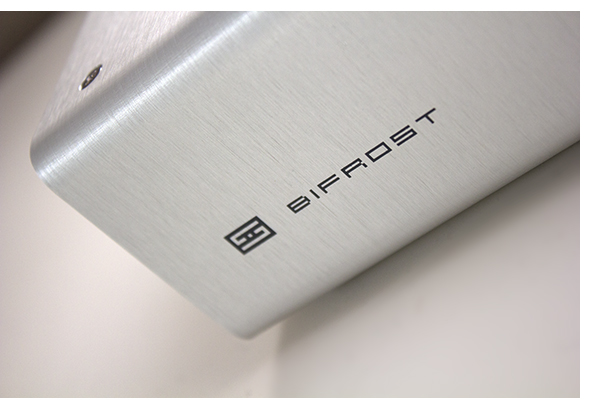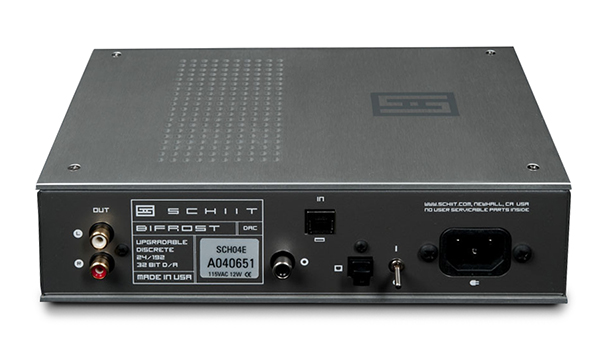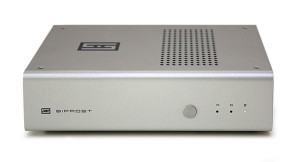Schiit Bifrost DAC Mini Mighty Marvel!
By John Darko
Cheaper DACs usually come with a slightly bitter spoonful of compromise. Manufacturer budget constraints mean less-effective jitter immunization or weaker power-supply regulation. Such shortcuts frequently tinge a DAC’s sound with a metallic edge, most easily heard on the decay of a cymbal strike or lilt of a piano. That natural shimmer present via more expensive models just isn’t there. In ultra-budget conversion boxes, soundstaging shrinks or inner-detail retrieval doesn’t plunge as deep. One must find the compromise with which they can live.
The Bifrost is the first of three DAC models coming from California’s Schiit Audio. Co-founders Mike Moffat and Jason Stoddard already weathered heat in audio forums due to their DAC’s FAQ page, on which they opine that USB-fed digital audio is McDonald’s in a world of healthier burger choices.
That said, they’ve taken the time to create a unique USB board for the Bifrost. It offers asynchronous transfer and handles up to 24/192. USB connectivity on the $349 baseline Bifrost is a $100 option at time of ordering, or $150 at a later date. And Schiit’s modular design approach means that any forthcoming DAC board upgrades can be retroactively fitted.
Inside, there’s no sample-rate conversion in the conversion recipe, and the chip choice—AKM 4399—is none too common. As evidenced by its established range of headphone amplifiers, Schiit takes pride in doing things its own way. Mavericks that dig the humor in flippancy? Perhaps.
My experience with numerous budget DACs mirrors the duo’s mirth toward USB audio transmission. All other things being equal, a budget DAC’s USB implementation isn’t as nourishing as its S/PDIF neighbor. Given both choices on a rear panel, I’ll run with the latter every time, even if doing so means spending additional dollars on an alternative transport or DDC. USB connectivity is little more than a handy convenience.
The Bifrost shows an even temperament across the frequency range; nothing stands out. It leans towards warmer sonic climes. Contrary to its tundra-evoking name, this new Schiit is more chili than chilly. Simple, clean cymbal strikes close each verse of The Rakes’ “Retreat,” but by way of the Bifrost, the music comes on as flavorful British indie-rock without the aluminum aftertaste. And a thicker mid-bass guitar and bass mulch keeps “Strasbourg” chugging, while Alan Donohoe’s boorish delivery never overbears during the shouty chorus.
Compared to my current king of the entry-level hill, the Audio-gd NFB2.1, Schiit’s debutant fares surprising well. It’s much easier to listen to for longer periods than its Chinese rival. The American contestant also wins on aesthetics and overall build quality—proving it’s possible to make something good, and for cheap, without having to off-shore the manufacturing process.
Under the Schiit’s command, pebbled smoothness underscores the languid seduction of Lana Del Rey’s debut EP. Indeed, the Bifrost is distinctly more laidback than the Audio-gd. On “Video Games,” the NFB-2.1 pushes a hint of caffeine into the upper registers of Del Rey’s mostly laconic delivery, translating into crisper transient definition of her inhale/exhale.
 Schiit’s presentation also shows more connective tissue than the NFB-2.1; there are fewer spatial cues. If this DAC stand-off took place in the amplifier space, the Schiit would likely represent a tubular faction. Greater congeal means more forgiveness of poorer recordings and greater overall body. The thick synth lines underpinning Phones’ remix of The Rakes’ “Retreat” impact with more squelch than via the Chinese entry. The two units are pretty much matched for detail retrieval, with the Audio-gd stealing the lead with ambient decay.
Schiit’s presentation also shows more connective tissue than the NFB-2.1; there are fewer spatial cues. If this DAC stand-off took place in the amplifier space, the Schiit would likely represent a tubular faction. Greater congeal means more forgiveness of poorer recordings and greater overall body. The thick synth lines underpinning Phones’ remix of The Rakes’ “Retreat” impact with more squelch than via the Chinese entry. The two units are pretty much matched for detail retrieval, with the Audio-gd stealing the lead with ambient decay.
Going back-to-back against the Schiit using Bjork’s “Hyperballad,” the NFB2.1 occasionally loses upper-mid composure. The Bifrost is kinder, warmer, softer. It also digs deeper into the lower bass notes. The Audio-gd box displays keener momentum, but is hampered by a tinge of brittle harshness when handling Bjork’s enthusiastic vocal turns. If the Audio-gd channels Jayne Mansfield, Schiit mainlines Marilyn Monroe. The former’s edginess is more arresting, the latter’s curvaceousness more seductive.
With a JKSPDIF MK3 turning USB into S/PDIF during these listening sessions, the latter still bests Schiit’s bespoke USB implementation. No shame in that. To their credit, Stoddard and Moffat narrow the quality gap between said input options. Performance disparity—transparency, tonal density, instrumental separation—between USB and S/PDIF (coaxial) isn’t as wide as with my other daily unit (a Rega DAC). The Rega’s sound connotes ectomorphic physique: lean, sharp, alert. The Schiit takes an endomorphic approach: rounded through the waist with a more obvious rear-end (ooh, matron!). The Bifrost’s treble errs more toward humid summer morning whilst the Rega’s cooler, damper autumn afternoon might be better suited to those already running tubes further down the line. The Rega works honeycomb crunch at its chocolate center, the Schiit yields praline and caramel.
For listeners that enjoy a warmer musical bath or whose setup is already (over)-enthusiastic at the top end, the Bifrost could well be the DAC to obtain. It doesn’t suffer the usual—and sometimes predictable—sonic compromises commonly found at its price point. Moreover, it isn’t better or worse than the Audio-gd; just different. And this distinction is a strong selling point.
As such, Schiit’s Bifrost concisely reveals there’s more than one route to happiness on the budget DAC trail. Additional applause goes to Stoddard and Moffat for making it all happen at a USA-based manufacturing facility. Excellent work, chaps.
You can read more insightful reviews from John Darko here:
 The Schiit Bifrost DAC
The Schiit Bifrost DAC
MSRP: Starting at $349



